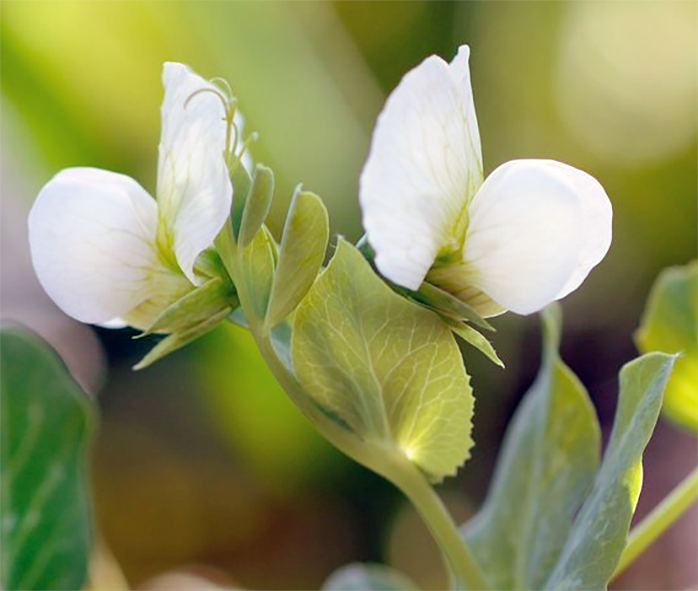 Garden Pea Flowers,
Pisum
sativum
flowers..
Garden Pea Flowers,
Pisum
sativum
flowers..
Welcome to the summary page for FabulousFusionFood's Edible Flowers guide to Pea Flowers along with all the Pea Flowers containing recipes presented on this site, with 1 recipes in total.
This is a continuation of an entire series of pages that will, I hope, allow my visitors to better navigate this site. As well as displaying recipes by name, country and region of origin I am now planning a whole series of pages where recipes can be located by meal type and main ingredient. This page gives a listing of all the Cornish recipes added to this site.
These recipes, all contain Pea Flowers as a major edible flower.
Peas are annual plants, with a life cycle of one year. They are a cool-season crop grown in many parts of the world; planting can take place from winter to early summer depending on location. The average pea weighs between 0.1 and 0.36 gram.[5] The immature peas (and in mange tout/snow peas the tender pod as well) are used as a vegetable.
The wild pea is restricted to the Mediterranean Basin and the Near East. The earliest archaeological finds of peas date from the late Neolithic era of current Syria, Anatolia, Israel, Iraq, Jordan and Greece. In Egypt, early finds date from c. 4800–4400 BC in the Nile delta area, and from c. 3800–3600 BC in Upper Egypt. The pea was also present in Georgia in the 5th millennium BC. Farther east, the finds are younger. Peas were present in Afghanistan c. 2000 BC, in the Harappan civilization around modern-day Pakistan and western- and northwestern India in 2250–1750 BC. In the second half of the 2nd millennium BC, this legume crop appears in the Ganges Basin and southern India.
Green 'garden' peas, eaten immature and fresh, were an innovative luxury of Early Modern Europe. In England, the distinction between field peas and garden peas dates from the early 17th century: John Gerard and John Parkinson both mention garden peas.[citation needed] Sugar peas, which the French called mange-tout, because they were eaten pods and all, were introduced to France from the market gardens of Holland in the time of Henri IV, through the French ambassador.
Just as pea shoots are edible, the flowers can also be eaten. Like the peas, pods and shoots, the flowers on pea plants have a mild pea flavour and they make an excellent addition to salads and garnishes for soups and stir-fries. Pea flowers are also steeped to make a tisane.
This is a continuation of an entire series of pages that will, I hope, allow my visitors to better navigate this site. As well as displaying recipes by name, country and region of origin I am now planning a whole series of pages where recipes can be located by meal type and main ingredient. This page gives a listing of all the Cornish recipes added to this site.
These recipes, all contain Pea Flowers as a major edible flower.
Peas are annual plants, with a life cycle of one year. They are a cool-season crop grown in many parts of the world; planting can take place from winter to early summer depending on location. The average pea weighs between 0.1 and 0.36 gram.[5] The immature peas (and in mange tout/snow peas the tender pod as well) are used as a vegetable.
The wild pea is restricted to the Mediterranean Basin and the Near East. The earliest archaeological finds of peas date from the late Neolithic era of current Syria, Anatolia, Israel, Iraq, Jordan and Greece. In Egypt, early finds date from c. 4800–4400 BC in the Nile delta area, and from c. 3800–3600 BC in Upper Egypt. The pea was also present in Georgia in the 5th millennium BC. Farther east, the finds are younger. Peas were present in Afghanistan c. 2000 BC, in the Harappan civilization around modern-day Pakistan and western- and northwestern India in 2250–1750 BC. In the second half of the 2nd millennium BC, this legume crop appears in the Ganges Basin and southern India.
Green 'garden' peas, eaten immature and fresh, were an innovative luxury of Early Modern Europe. In England, the distinction between field peas and garden peas dates from the early 17th century: John Gerard and John Parkinson both mention garden peas.[citation needed] Sugar peas, which the French called mange-tout, because they were eaten pods and all, were introduced to France from the market gardens of Holland in the time of Henri IV, through the French ambassador.
Just as pea shoots are edible, the flowers can also be eaten. Like the peas, pods and shoots, the flowers on pea plants have a mild pea flavour and they make an excellent addition to salads and garnishes for soups and stir-fries. Pea flowers are also steeped to make a tisane.
The alphabetical list of all recipes on this site follows, (limited to 100 recipes per page). There are 1 recipes in total:
Page 1 of 1
| Wisteria, Chickweed and Pea Flower Spring Rolls Origin: America |
Page 1 of 1